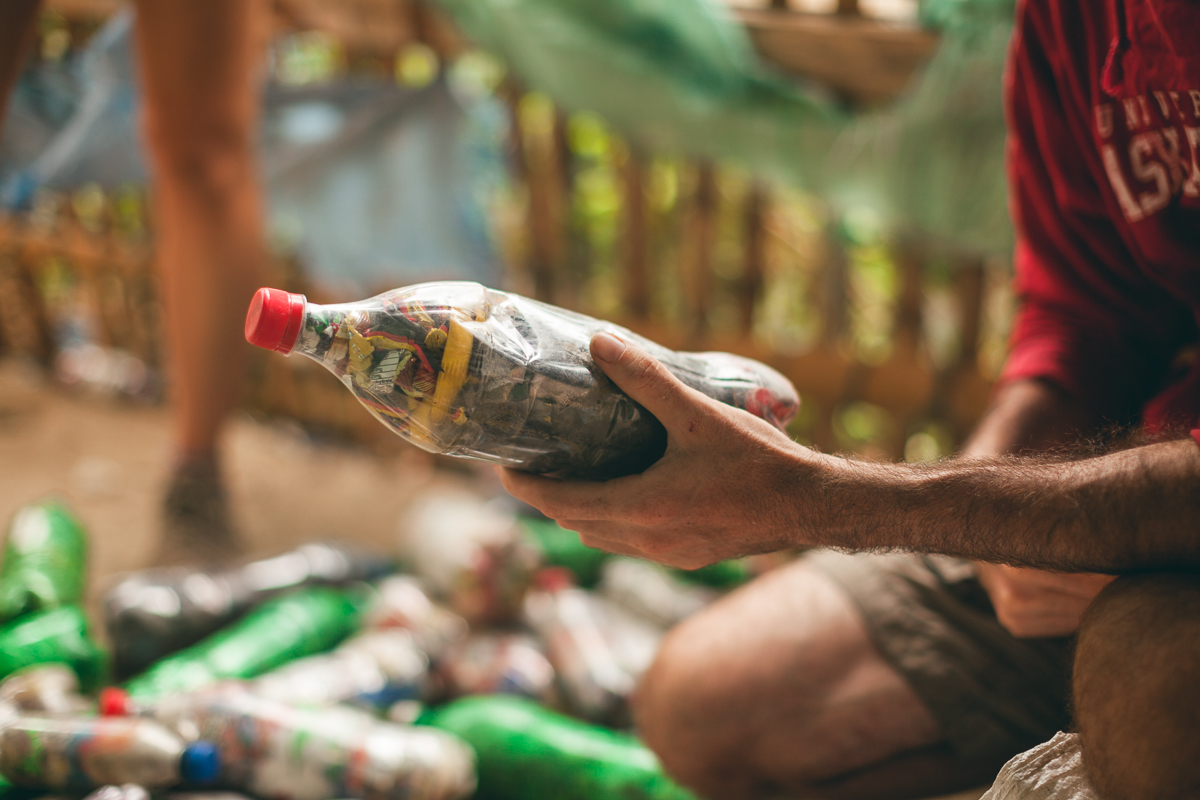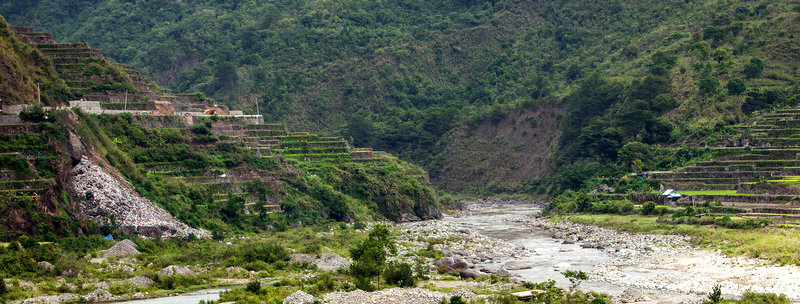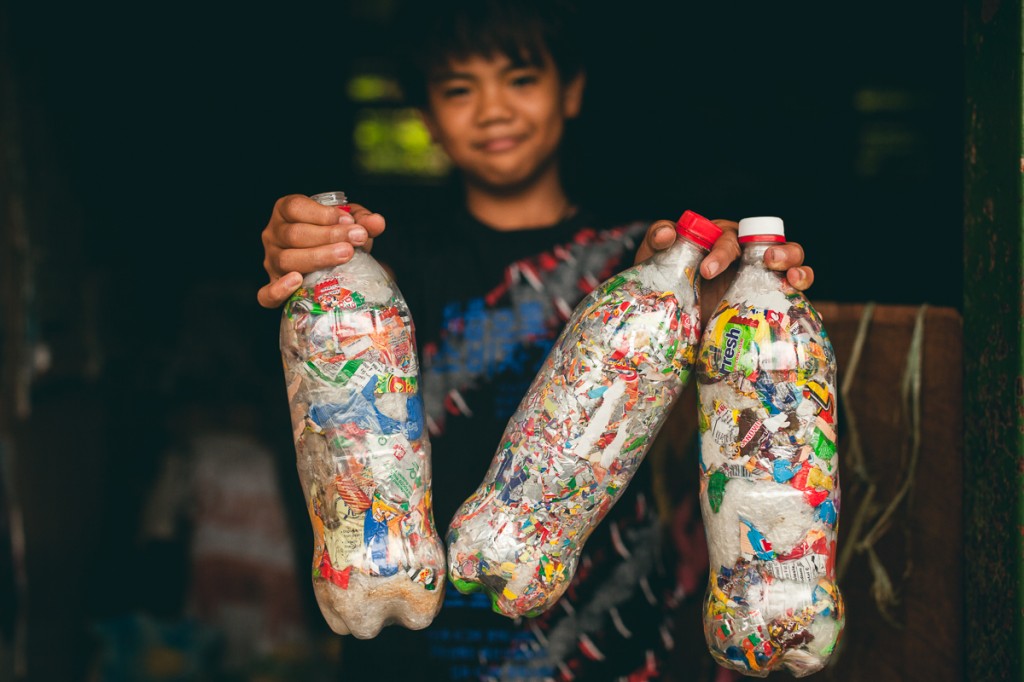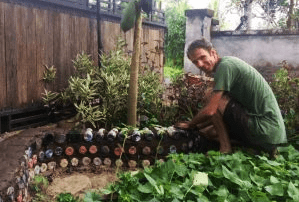We’re investigating the efficacy of Ecobricks as a community solution to solid waste in the Northern Philippines. Ecobricks are made by packing solid a PET bottle with non-recyclable, non-biodegradables (i.e. plastic, cellophanes, styrofoam, etc). An essential part of our investigation is ethical. It is crucial to weigh the long-term consequences of making a building block from potential toxics. Short term the benefits have been clearly observed in our pilot-schools: encouraging segregation, avoiding short-term contamination, enabling personal waste responsibility, and introducing a low-cost construction alternative.
Yet, what about the long-term? After all, not thinking about the destination of our designs is precisely the cause of pollution today. The stashed ‘trash’ does not go away. Are we not passing the problem to future generations?
We can pose the question using the framework of William McDonough, the theorist behind Cradle-to-Cradle design ethics(*1):
”How do we love all of the children of all species for all time [with our designs]? You notice that this is not how do we love our children. This is all of the children of all of the species for all time.’‘ — William McDonough
Thus we can ask: Is Ecobricking good for all the children of all the species for all time?
I have been carefully observing the application of Ecobricks in my mountain community for two years. After much reflection and conceptual crafting of the Ecobrick methodology, I argue that Ecobricks are a indeed a viable solution to be pursued immediately. First, Ecobricking, is a consciousness raising process that gets to the root causes of pollution and accelerates the transition from linear to circular thinking– the laborious process of Ecobricking encourages reflection on the very nature of ‘trash’ and one’s personal waste responsibility. Second, Ecobricks enable the long term retention of control of materials that in all other eventualities would become toxic– when Ecobricks are used within a cycle context of planned-destruction building, Ecobricks can technically be infinitely recycled. Third, Ecobricking are a imminently practical solutions for communities with inadequate recycling– they are are a zero-cost, immediate, all-generation, solid waste solution without the need of special skills, equipment, facilities, finances or political permission. Fourth, Ecobricks have the tendency to be used in constructing communal green spaces– when applied with the principles of permaculature Ecobricks can greatly enhance our relationships with surrounding species. There are pitfalls to Ecobricking, but when disseminated with guidance, these four aspects of Ecobricks result in a cradle-to-cradle, infinitely recyclable waste and building solution. In this way, Ecobricks can indeed enrich the lives of our children and the children of all species for all time.
First, let us review the context of this essay and the perspective of Ecobricks that we will follow. I began exploring packing plastics in my home in a small mountain village in the Philippine Cordilleras. In my community there was simply no reasonable place to ‘throw away’ my non-biodegradable waste. The fact that I could see the river where my plastics were going was a powerful motivation to seek alternatives. The situation in my village is a revealing example of a situation common, yet often hidden, in countless places around the world. (*2) After all, for a piece of plastic, where is ‘away’?
To see clearly the role of Ecobricks, let us take a look at an example one such piece of plastic. I love coffee. In the nearby town they grow and roast great coffee. It is sold in a brown silver-lined bag to preserve its freshness. The bag, like countless other consumer packaging, is made from linear low-density polyethylene. This substance does not harmonize into the local ecology– when burned it creates toxic dioxins, when dumped it clogs waterways and impedes the lifecycles of aquatic organisms, when left to be, it photogrades into small particles and coagulates poisonous PCBs.
Once I am done with my coffee beans, the plastic’s use is over– it has become what we commonly call trash, or here basura. Before I began ecobricking, my ‘basura’ would go into a segregated bin in my home. The contents of that bin would then be collected by the municipality and would go to one of the towns official or unofficial dump sites. Most often this is off a cliff, near the river, or in an isolated rural area.
Through this process, control of the item is lost. Through fumes, ashes, and photo-degradation the coffee bag and its component chemicals seep into the surrounding web of life. There, the dioxins and coagulated PCBs begin their poisonous journey through the food chain.
The key element in this transition of product to pollution is control. When I still had control of the coffee wrapper within my home there was no overt contamination. Recycling or upcycling is retention of control. Yet, when this is not available, there is simply no other place for it to go. In a region like mine, countless types of non-biodegrade wastes (like my plastic coffee bag) are on such a one way journey. Even when recycling occurs (such as with some PET bottles) the plastic is simply cycled into a lower non-recyclable grade with a one-time-use. The final attempt at retaining control is a dump site. Alas, when we begin to extend the time frame from 20 years to 100 years, even a dedicated dump site is not a solution. Examples of water table contamination in ‘engineered landfills’ in Canada, Germany and Switzerland testify to this.(*2) Control literally seeps away.
The journey of my coffee bag is of course that of all the non-biodegradables in my bin. The fate of the contents of my bin is that of everyone’s’ in my town, of the towns of all the province, of all the provinces in the Philippines. Whether it is a decade or a century, this inexorable flow and the inextricable contamination of local ecosystems is unquestionably not in the interest of our children, and the children of all species for all time.
Enter Ecobricks.
First and most significantly, the very process of Ecobricking gets to the roots of pollution in collective consciousness. Pollution is fundamentally caused by short sighted thinking. For those who have never made an Ecobrick, it is a time consuming, monotonous and laborious process. It can take hours of dedicated work and a large sack of plastic to make a single 0.5kg Ecobrick. The process is inherently meditative. It lends itself towards existential reflection on each piece of “trash” being stashed and its otherwise linear route: Where did it come from? Where is it going? Why is it here? Where will it be in 100 years? (Would it be better to just grow my own coffee?). To honor future generations and other species, we must begin by thinking of them. Ecobricks provide an absolutely invaluable spark to such reflection (this very article and your reading of it is an example of this). Ecobricks become a catalyst to envisioning one’s lifestyle in deeper harmony with the circles of life.
“Where Do We Come From? What Are We? Where Are We Going?”
-Gaugin“Where did it come from? What is it? Where is it Going?”
-Ecobricks
Secondly, making an Ecobrick makes use of the very problem (the longevity of the plastic) to seal the potential toxics away. In the words of Bill Watson, founder of the principles of permaculture “The problem is the solution”. PET bottles are readily available in regions were recycling facilities are inadequate. Because of the incredible longevity of PET that is protected from UV rays, Ecobricking becomes a halt to the linear flow of waste and an infinitely recycleable building block. When applied properly, Ecobricks become a real world LEGO block. Ecobrick documentation directs using cob* (as opposed to cement) to build with. Bricks are laid completely encased in cob mortar so that there is no UV exposure to the PET plastic. When an Ecobrick construction comes to its end, the cob mortar crumbles to allow easy separation of intact bricks from the rubble for the next construction. An Ecobrick thus becomes a cradle-to-cradle, infinitely reusable building-block.* In such a way, Ecobricks open the way for a virtually infinite cycling of ‘non-biodegradeables’ (or as technical nutrients in the parlance of cradle-to-cradle). Over the course of time, ecobricks that are damaged or ruptured are broken apart and put into a new Ecobrick. Rather than handing future generations ecosystems that are cocktails of contamination we hand them a nutrient cycle of useful, reusable, segregated building blocks. The linear flow of waste transitions into a circle of utility.
“If we think about things having multiple lives, cradle to cradle, we could design things that can go back to either nature or back to industry forever.” — William McDonough
Thirdly, Ecobricks are an imminently practical solution. Ecobricks are demonstrably effective, zero-cost, viral and communal solution to communities in the global south that are languishing in scattered solid waste. Ecobricking lets the populace take control of their solid waste predicament. Unlike other recycling or up-cycling techniques, no special skills, equipment or facilities are required to make Ecobricks. In fact, Ecobricks are best made by the young and old, thus enabling the majority of the community to take part. When implemented as a community solution, ecobricking becomes an accepted, everyday, long term habit for citizens. Through widespread collaboration plastics are put to use by communities for the communities.
Finally, because completed Ecobricks were made by many they, lend themselves towards constructions that serve the community. Ecobricks have the tendency to be used for building green spaces: parks, herb gardens, and food forest (including coffee planters). In this way, Ecobricks both protect and enrich the futures of our children and the surrounding species.
It is helpful to sum up with one of the most telling observations that we have noted in our pilot communities. In these towns we have noted the disappearance of trash– both on the streets and most significantly, the core concept of ‘trash‘. In truth it is this problematic linear concept of ‘an object who’s value has been consumed‘ that is the root of pollution. With Ecobricks, non-biogreadables that once had no further use or value (i.e. trash), now become use-full and endowed with a new life– a life that inherently contains the plan for future cycles. This transition from dead to alive, from worthless to use-full, from linear to cyclical, is integral. It is a transition from the endemic linear thinking of the current human world, to that of the cycles and circles that characterize nature– or more aptly, the real world.(*4)
“A problem cannot be solved by the same consciousness that generated it.” –Albert Einstein
If there is any danger in Ecobrick technology it is that this transition from linear to cyclical thinking is not made. Afterall, the destiny of any technology is wrought by the consciousness that wields it. When Ecobricks are attempted through the same linear trash consciousness (i.e. not thinking about the next life of the Ecobrick) further pollution, whether in a decade or a century, is the unavoidable result. When Ecobricks are improperly packed, when cement is used in construction, when only one type of bottle is used, constructions become weak, soda consumption rises, and worse of all, constructions are impossible to dissemble in a way that enables Ecobricks to find their next cradle. A bigger mess is left than when we began! For proponents of Ecobricks there is a moral responsibility in ensuring that the proper guidance and documentation are in place to ignite the requisite jump in thinking. Fortunately, through social media and the web it is possible to stay ahead of word-of-mouth spread. Our work with developing Ecobricks has also included the development of a free Vision Ecobrick Guide that is readily available for free download. See Ecobricks.org
Ecobricks in themselves are simply another plastic product. Yet, they present the opportunity to think and create differently– to turn the line of product to pollution into a circle of cycling, controlled and use-full technical nutrients. They let us hand future generations and our neighbor species a healthier environment– indeed using Ecobricks we can build just that beautiful green space. In this way, Ecobricks are an essential stepping stone in our transition to a deeper harmony with the cycles of life– and the sooner we start packing, the better for all the children, of all species, for all time.
_____________________
Footnotes
1. McDonough argues that products should be designed from cradle to cradle rather than cradle to grave. Designers must think about the end of their products life and ensure that every aspect of it can be cycled through either natural or industrial nutrient cycles. The first principle of Cradle to Cradle design states: “Everything is a resource for something else. In nature the discharge of one system becomes food for another. Buildings can be designed to be disassembled and safely returned to the soil (biological nutrients), or re-utilized as high quality materials for new products and buildings (technical nutrients).”
2. On first glance my village waste situation seemed unique. I have come to see that it is in fact the norm and the hidden reality of cities with even the seemingly most advanced solid waste systems. The documentary “Bag It”. 2010 documentary by Suzan Beraza argues that this is the case in countries with even the most seemingly advanced recycling systems.
2. Winnipeg dump site and Munich dump sites. Citacion pending…
3. Cob is an ancient building method also known as adobe. Cob is made from sand, clay, and straw. Instructions on how to prepare cob are included in our Vision Ecobrick Guide.
4. Interestingly enough, in the languages of the indigenous Igorot people of my area, before Western contact, there was no word for trash in the language, and of course no pollution. There were no linear concepts or processes, only circles.




